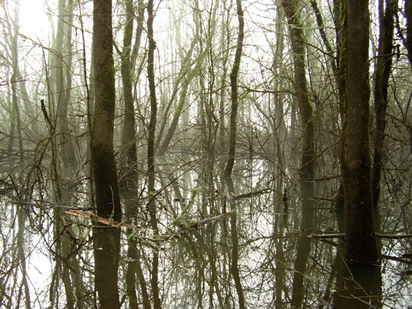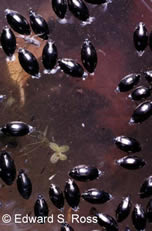| |
Wetlands are highly productive areas that are neither entirely terrestrial nor entirely aquatic. The ground is saturated for at least part of every year, which influences the types of plants that can grow there and the characteristics of the soil. You may have heard a variety of terms used to describe wetlands, including: marsh, bog, swamp, slough, or fen. There are many different ways to classify wetlands.
IMPORTANCE OF WETLANDS
Wetlands are rich, diverse ecosystems that provide critical habitat for many birds, amphibians, reptiles, insects, mollusks, crustaceans, and other organisms. |
|

|
About 40% of all species listed as threatened or endangered in the U.S. depend on wetlands for their survival. In the Willamette Valley of Oregon, migrating birds depend heavily on the abundant invertebrate food resources available in many wetlands. Wetlands provide the important ecosystem service of water purification; they can filter large quantities of sediment, excess nutrients and bacteria. To take advantage of this benefit, artificial wetlands are now intentionally constructed to treat municipal waste water, landfill runoff, acid mine drainage, and other types of waste water. Wetlands also play an important role in flood prevention, absorbing large quantities of water over a wide surface area, then slowly releasing that water over time. Wetlands also provide areas in the landscape where people can hunt, fish and go bird watching.
THREATS TO WETLAND HABITATS
In the past, wetlands were generally viewed as unproductive areas that were not suitable for farming or development. These areas were destroyed or degraded through filling, tiling, draining, and other methods. Over half of the 200 million acres of wetlands that existed in the U.S. before European settlement have been lost, and many of those that remain intact suffer from a variety of human impacts, including pollution, changes in water flow, and invasive species. Only in the past few decades have state and federal agencies recognized the value of wetland habitats, both to humans and biodiversity.
Currently, when wetlands are removed from the landscape, often to build commercial or residential structures, the person responsible may be required to mitigate for the loss of that habitat. However, methods are not readily available to determine if a mitigated wetland fills the same ecological role as the lost wetland. The Xerces Society is currently involved in an effort to develop invertebrate bioassessment tools to evaluate wetland restoration or mitigation success. |
Ephemeral wetlands and the animals that depend on them are especially vulnerable to global climate change. In arid areas, as the temperature rises and the water supply falls, many of these wetland habitats are in danger of completely drying out. Decreased water in wetlands may increase the concentration of the pollutants that are already present, making the water more toxic for the wetland dependant biota. In the Pacific Northwest, global climate change will likely bring increased, earlier winter rains and hotter, drier summers, which will alter the natural hydroperiod of wetlands. It is unknown how this change in hydroperiod will affect wetland invertebrates and other animals. |
|
|
| |
| WETLAND INVERTEBRATES |
 |
|
Invertebrates in wetlands are diverse and abundant. They are one of the bottom rungs of the food chain, supplying nutrients to birds, fish, amphibians, and mammals. The economic value of invertebrates in the U.S. has been estimated at roughly $57 billion (Losey and Vaughan 2006, pdf ~4 MB), with nearly $50 billion of that linked to the recreation industry. Without aquatic invertebrates to feed fish, the sportfishing industry would have a hard time existing; American's spend billions on birdwatching and migratory bird hunting every year; many of those birds depend on aquatic insects for their survival.
View a list of invertebrate taxa that The Xerces Society found in riverine-impounding wetlands in Oregon's Willamette Valley. |
WETLAND CLASSIFICATION
There are a number of classification systems used for wetlands. A great description of the many wetland classification systems in use is available in the EPA module #7, Methods for evaluating wetland condition: Wetlands Classification. Two commonly used classification systems include the Cowardin (1979) classification system and the Hydrogeomorphic or HGM (Brinson, 1993) classification system. The Cowardin classification system was developed by the U.S. Fish and Wildlife Service. A good description of this classification system is available on the Northern Prairie Wildlife Research Center (USGS) website. The Hdyrogeomorphic classification system is based on the hydrological and geomorphological characteristics of a wetland. This system was developed after the clean water act went into effect as a way to evaluate wetland function.
|
|
|
